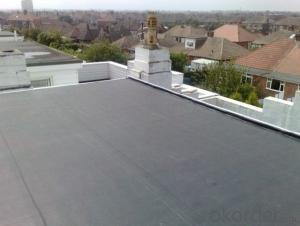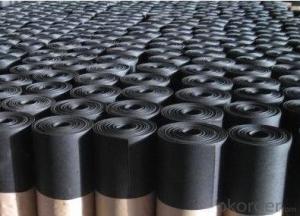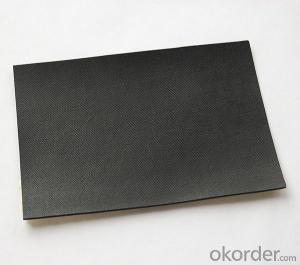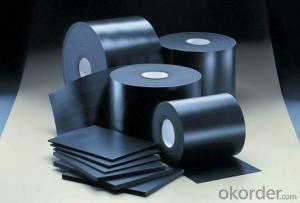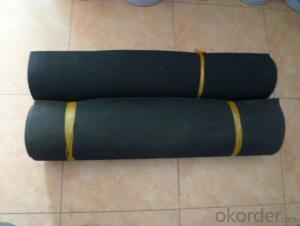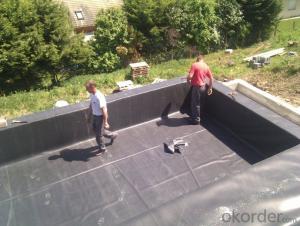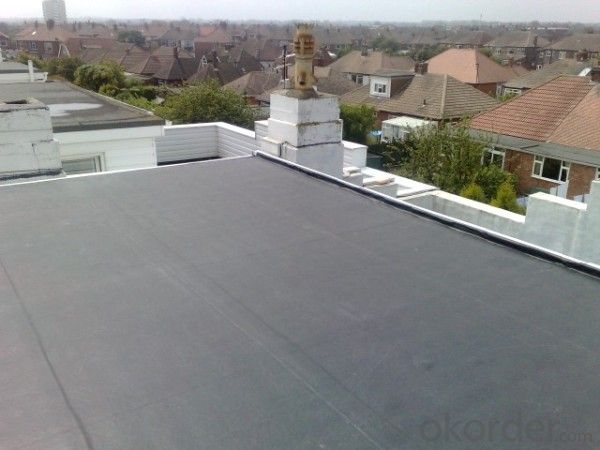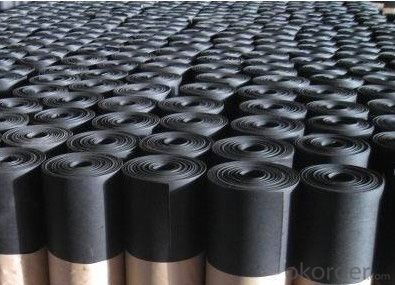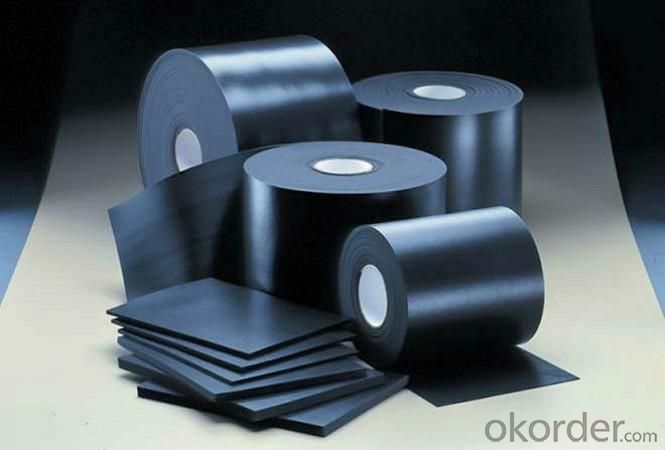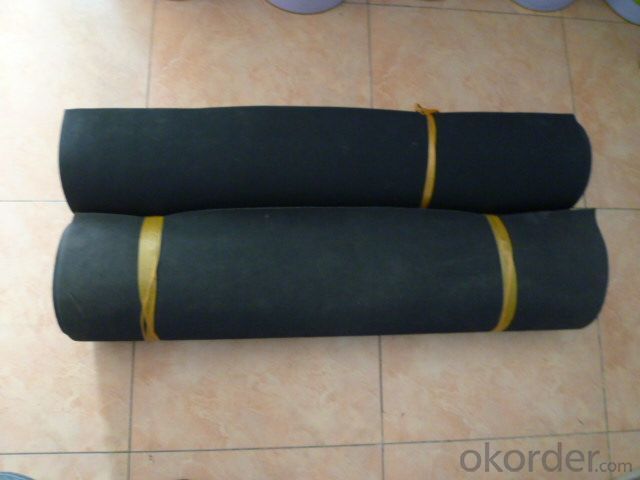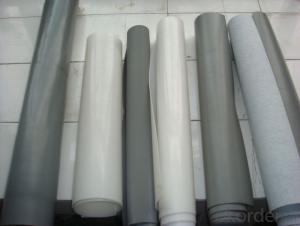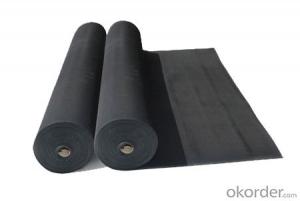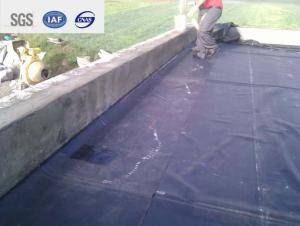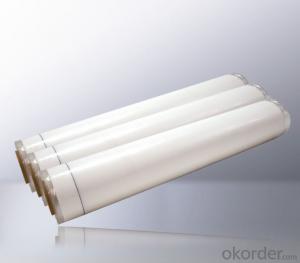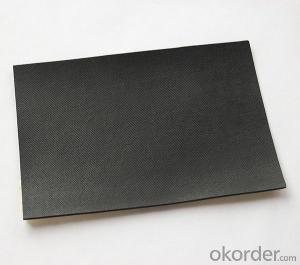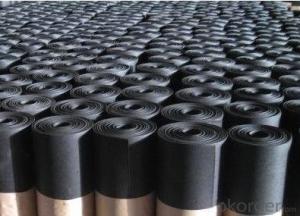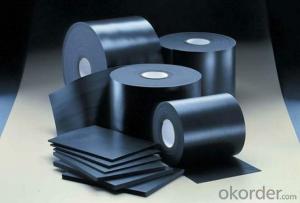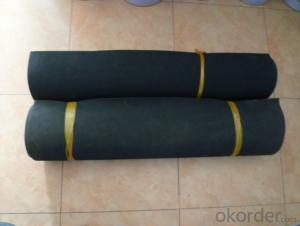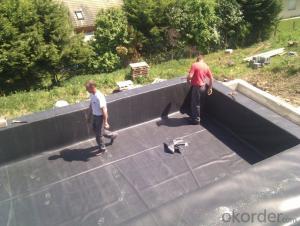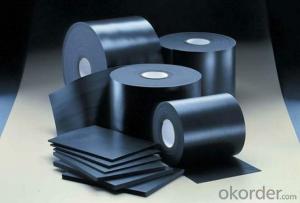EPDM Rubber Waterproof Membrane with 4m Width
- Loading Port:
- Shanghai
- Payment Terms:
- TT OR LC
- Min Order Qty:
- 50000 m²
- Supply Capability:
- 5000000 m²/month
OKorder Service Pledge
OKorder Financial Service
You Might Also Like
EPDM Rubber Waterproof Membrane with 4m Width
Description Of EPDM Rubber Waterproof Membrane with 4m Width:
This waterproof coiled material is of high elasticity with best performance among high polumer waterproof coiled material in the world.It is also the most typical one in the world.Waterproof coiled material made of ternary ethylene-propylene rubber is produced with the use of the most advanced contiuous extrusion and vulcanization technology and related equipments which are specially designed for production of such product.It is good in compactness,without bubble and performance difference in length and breadth,perfomances reach or exceed the demands of GB18173.1-2000 standard.
Main Features of EPDM Rubber Waterproof Membrane with 4m Width:
1.EPDM waterproof membrane for bridge engineering waterproof
2.EPDM waterproof membrane for water conservancy projects ,such as river bank,lake dam seepage.
3.EPDM waterproof membrane for the municipal engineering.
4.EPDM waterproof membrane for aquaculture.
Specifications of EPDM Rubber Waterproof Membrane with 4m Width:
| Number | Item | Unit | Value | |
| 1 | Size Variation | Thichness | % | ±10 |
| Width | % | ±1 | ||
| Length | % | Allowed negative | ||
| 2 | Breaking tensile strength at normal temperature | Mpa | ≥7.5 | |
| Breaking tensile strength at 70°C | Mpa | ≥2.3 | ||
| 3 | Breaking elongation at normal temperature | % | ≥450 | |
| Breaking elongation at -20°C | % | ≥200 | ||
| 4 | Tear strength | KN/m | ≥25 | |
| 5 | Impermeability(30min) | * | 0.3Mpa no leakage | |
| 6 | Bending at low tempreture | °C | ≤-40 | |
| 7 | Stretch tensor at heating | Elongate | mm | ≤2 |
| Shrink | mm | ≤4 | ||
| 8 | Air oven aging(80°C×168h) | Tensile strength at break retained | % | ≥80 |
| Elongation at break retained | % | ≥70 | ||
| 9 | Anti-alkali | Tensile strength at break retained | % | ≥80 |
| Elongation at break retained | % | ≥80 | ||
| 10 | Nuture weathing at manual simulation | Tensile strength at break retained | % | ≥80 |
| Elongation at break retained | % | ≥70 | ||
Applications of EPDM Rubber Waterproof Membrane with 4m Width:
Widely used in roofs, basement, toilet ,swimming pool, and all kinds of industry and civil building waterproofing, reservoir, vivicism, bridge, underground, tunnel and dam waterproofing ,especially to the keystone waterproofing projects which is durability, high corrosion resistance and easy deformation.



IMages of EPDM Rubber Waterproof Membrane with 4m Width:




FAQ of EPDM Rubber Waterproof Membrane with 4m Width:
1. What are we supplying?
We are specialized in producing Colorful Asphalt Roof Shingle, SBS/APP modified bitumen waterproof membrane, Self adhesive bitumen waterproof membrane, PVC waterproofing membrane, EPDM rubber roofing membrane, Single Component Polyurethane Waterproof Coating, and Spray Polyurea Waterproof Coating
.
2. How Many years experience do we have?
We have been exported to more than 20 countries in the past 15 years.
3. How long do we usually reply your request?
We always reply our customer within 24 hours.
- Q: Can a waterproofing membrane be applied on curved surfaces?
- Indeed, curved surfaces can indeed be coated with a waterproofing membrane. In reality, waterproofing membranes are designed to possess flexibility and adaptability, which render them suitable for usage on a variety of shapes and contours, including curved surfaces. These membranes are typically constructed from materials like modified bitumen, polyurethane, or rubber, all of which possess exceptional properties of elongation and flexibility. Thus, they can be easily shaped and stretched to conform to curved surfaces without compromising their waterproofing abilities. Consequently, structures featuring curved components like roofs, balconies, tunnels, and tanks can be effectively waterproofed. However, proper installation techniques and specialized tools may be necessary to ensure appropriate adherence and complete coverage on curved surfaces. Nevertheless, with the appropriate expertise and materials, successful application of waterproofing membranes on curved surfaces can be achieved.
- Q: Can a waterproofing membrane be used on bridges?
- Yes, a waterproofing membrane can be used on bridges. It is a common practice to use waterproofing membranes on bridge decks to protect them from water infiltration, which can cause damage and deterioration over time. The membrane acts as a barrier, preventing water from penetrating the bridge deck and protecting the underlying structure.
- Q: Can a waterproofing membrane be painted over?
- Yes, a waterproofing membrane can be painted over. However, it is important to ensure that the membrane is properly prepared and any necessary primers or sealers are applied before painting. It is also recommended to use a paint specifically designed for application on waterproofing membranes to ensure durability and long-lasting results.
- Q: Can a waterproofing membrane be used on stucco surfaces?
- Indeed, stucco surfaces can benefit from the application of a waterproofing membrane. Due to its porous nature, stucco has the ability to absorb water. Thus, the utilization of a waterproofing membrane can effectively deter water infiltration and consequential damage. Acting as a barrier, the waterproofing membrane hinders water from permeating the stucco and compromising the underlying structure. Furthermore, it safeguards the stucco from moisture-related complications like cracking, mold, and mildew. It is imperative to select a waterproofing membrane specifically designed for stucco surfaces and adhere to the manufacturer's instructions for proper installation. Moreover, routine inspections and maintenance of the waterproofing membrane are highly recommended to ensure its efficacy and durability.
- Q: Can waterproofing membranes be used on retaining walls?
- Retaining walls can indeed benefit from the application of waterproofing membranes. It is quite common to utilize these membranes on retaining walls in order to hinder the infiltration of water and safeguard the structure against issues arising from moisture, such as seepage, efflorescence, and cracking. These membranes act as a barrier, effectively preventing water from permeating the retaining wall and causing harm. Typically, they are installed on the exterior side of the retaining wall, providing an added layer of protection against water intrusion. There is a wide range of waterproofing membranes available, including sheet membranes, liquid-applied membranes, and cementitious coatings, allowing for the selection of the most suitable option based on the specific requirements and demands of the retaining wall.
- Q: Can a waterproofing membrane be used on precast stone surfaces?
- Indeed, the utilization of a waterproofing membrane is viable on precast stone surfaces. Similar to all other concrete or masonry surfaces, precast stone surfaces are prone to water infiltration, which may lead to long-term damage. By applying a waterproofing membrane onto the precast stone surface, one can effectively prevent water penetration and shield the stone from moisture-related problems such as cracking, spalling, and efflorescence. This membrane establishes a barrier that hinders water seepage into the stone while still permitting it to respire and release any trapped moisture. Hence, it is crucial to select a waterproofing membrane that is compatible with the precast stone material and meticulously adhere to the manufacturer's instructions for proper application.
- Q: Can a waterproofing membrane be used in historical or heritage buildings?
- Indeed, historical or heritage buildings can utilize a waterproofing membrane. Nevertheless, prior to implementing any waterproofing solution, it is imperative to take into account the specific requirements and sensitivities associated with these types of structures. Historical or heritage buildings often possess distinctive architectural characteristics, materials, and construction methods that necessitate preservation and safeguarding. When employing a waterproofing membrane in historical or heritage buildings, it is of utmost importance to choose a product that is compatible with the existing materials and will not cause any harm or modification to the structure. It is advisable to seek guidance from a professional architect or preservation specialist with expertise in working with historical buildings. This will ensure that the chosen waterproofing membrane is appropriate for the specific needs of the building. Furthermore, it is vital to consider the visual impact of the waterproofing membrane on the building's appearance. Historical or heritage buildings frequently showcase unique architectural details and façades that contribute to their character and value. Hence, the selection of the waterproofing membrane should be done with great care to ensure that it does not detract from the building's historical significance or visual allure. In conclusion, while it is possible to employ a waterproofing membrane in historical or heritage buildings, it should be done with caution. The utmost consideration should be given to the building's materials, construction techniques, and aesthetic worth to guarantee that the waterproofing solution does not compromise the structure's integrity or historical importance.
- Q: Can a waterproofing membrane be used for planters or raised beds?
- Yes, a waterproofing membrane can be used for planters or raised beds to prevent water leakage and protect the surrounding areas from potential damage.
- Q: Can a waterproofing membrane be used on both interior and exterior surfaces of a structure?
- Yes, a waterproofing membrane can be used on both interior and exterior surfaces of a structure. It is designed to create a barrier that prevents water penetration, whether it is applied on the inside or outside of a building.
- Q: Are waterproofing membranes resistant to sewage?
- Waterproofing membranes exhibit resistance towards sewage, as they are tailor-made and produced to serve as a shield against diverse liquids, including sewage. Crafted from robust materials, these membranes possess the capability to endure sewage exposure and prevent any leakage or seepage. By establishing a safeguarding layer, waterproofing membranes effectively ward off sewage intrusion and safeguard the integrity of the underlying structures. This resistance to sewage renders waterproofing membranes a highly efficient remedy for locales susceptible to sewage backup or elevated moisture levels, such as basements, bathrooms, and water treatment facilities.
Send your message to us
EPDM Rubber Waterproof Membrane with 4m Width
- Loading Port:
- Shanghai
- Payment Terms:
- TT OR LC
- Min Order Qty:
- 50000 m²
- Supply Capability:
- 5000000 m²/month
OKorder Service Pledge
OKorder Financial Service
Similar products
Hot products
Hot Searches
Related keywords
